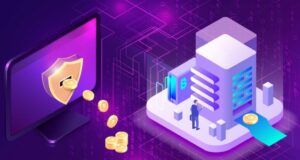What is DePin in Crypto?
Key Takeaways
- DePIN provides a new decentralized model for building and maintaining physical infrastructure. Compared to conventional, centralized approaches, it offers increased scalability, flexibility and local control.
- Blockchain, smart contracts, and Internet of Things (IoT) devices are the foundational technologies powering secure and efficient DePIN networks. They encourage more transparent operations and help automate processes.
- Community engagement and public participation are fundamental to DePIN’s success. They advance the interests of local stakeholders to gain direct control, maximize efficiency, and reap the rewards from these valuable network resources.
- DePIN models have demonstrated their real-world value already! They lower costs of infrastructure, increase data privacy, democratize access and accelerate innovation in industries such as wireless connectivity, data storage and energy grids.
- Current challenges that DePIN adoption will need to overcome range from navigating technical complexities, robust security maintenance, evolving regulatory climates, and creating user-friendly interfaces.
- To truly achieve sustainable, long-term growth, DePIN projects will require robust economic models, continuous community engagement, and the ability to pivot as technologies and policies develop.
Depin short for Decentralized Physical Infrastructure Networks. This cutting-edge model powers physical infrastructures such as Wi-Fi, storage, and electric vehicle chargers through decentralized blockchain technology!
Instead of one big company in charge, depin lets lots of people help run the network and earn small rewards. Most of these projects leverage crypto tokens to incentivize users by compensating them when they contribute their hardware or services.
Our aim has always been to bring equity, transparency, and cost-effectiveness to all networks. Here in the United States, people have applied depin for city-wide Wi-Fi and local delivery fleets.
They go so far as to monitor air quality using actual sensors! In upcoming pieces, we’ll be diving into some of the key tech making depin possible. Join us to learn about practical applications and what you need to know before implementing it!
What Exactly is DePIN?
DePIN, or Decentralized Physical Infrastructure Networks, is an emergent paradigm that introduces a revolutionary approach to creating and overseeing tangible systems in our world. At its most basic, DePIN ties blockchain networks to physical assets. This link enables individuals and organizations from different backgrounds to pool efficiencies and run facilities and services independent of any sole controller.
This configuration represents a radical departure from previous paradigms. In those models, there was one company or one agency that was in charge of the grid, the network, the system. Fast forward to 2024, with crypto markets re-energized, DePIN shines as a dynamic sector of advancement. It has the potential to transform what we know about energy, transportation and communications. By decentralizing control, it lowers the barrier for everyone to participate.
1. Defining Decentralized Physical Networks
A decentralized physical network distributes control and resources in a way that one entity cannot dominate the network. These networks leverage blockchain technology to record actions, determine rewards, and maintain equity. Community input is the best part—everyone can contribute spare storage, bandwidth, or energy, and earn money in return.
For instance, a community could organize to operate decentralized wireless hotspots. They might even operate solar panels, providing a more resilient and far-flung public good.
2. DePIN vs. Old Infrastructure
Unlike old infrastructure networks that are either failing to meet increasing demand or incompatible with emerging technologies, DePIN provides an alternative. DePINs are easily scalable by default because anyone can contribute resources. This way, there’s reduced risk of single points of failure, and the whole system is more adaptable.
In contrast to these centralized models, ownership becomes decentralized, distributing the ownership, the stake, and ultimately the say across a much larger group.
3. Core Tech Powering DePIN
Blockchain is one of the core technologies we need to power DePIN. Smart contracts are self-executing contracts that automatically execute deals, maintain track of transactions, and establish rules. By tokenizing the network, those that provide positive value are rewarded.
At the same time, IoT devices are aggregating real-time data and connecting the virtual ecosystem to tangible assets.
4. Key Parts of DePIN Systems
Nodes operate and maintain the network decentralization. Tokens create incentives for contributions. Protocols define rules of the network. These key components merge, connecting digital trust to physical action.
User-friendly interfaces and processes encourage participation, contribution, and utilization, without requiring extensive technical expertise.
5. My View: A True Paradigm Shift
DePIN flips the playbook—control and value should belong to everyone, not just a handful of insiders. This might power more equitable access, innovative commercial frameworks, and alternative governance structures for collective resources.
How DePINs Actually Function
DePINs, or Decentralized Physical Infrastructure Networks, operate by connecting blockchain technology with physical-world infrastructure. They incentivize users and providers to construct, utilize, and expand commonly-owned infrastructures. This model provides an innovative way to deploy and operate wireless infrastructure, storage, or data pipelines.
It provides users with real value and utility by offering them greater control, flexibility, and opportunities to earn rewards.
The DePIN Operational Flow
Establishing a DePIN The process begins when individuals or entities contribute resources—such as bandwidth, sensors, or data storage—to the network. These resources are logged, stored, and transferred on a blockchain. This makes sure that every action taken is auditable and immutable.
These roles can be divided into three categories: resource providers, resource users, and validators who verify the work done. Feedback loops use real-time data, so the system can tweak how it runs, spot weak spots, and boost what works.
This live feedback is useful for determining equitable rewards, ensuring that individuals are compensated according to their contributions.
Understanding the Flywheel Effect
Understanding the Flywheel Effect DePINs operate with a flywheel effect. The more users that come on board and contribute value, the more useful the network gets, which attracts even more users. Incentives—usually in the form of crypto tokens—continue to lure participants.
In decentralized wireless networks, an increasing number of hotspots improves the coverage. This incremental improvement draws more users onto the network and yields the network providers higher rewards.
Success stories, such as Helium, illustrate how these cycles facilitate rapid, cheap, organic expansion.
Who Builds and Uses DePINs?
Who Builds and Uses DePINs
Builders are the primary developers, investors, and average users. It takes developers to deploy the tech, investors to fund it, and users to power the network. Collaboration between the community and creators is essential.
DePINs touch on several different sectors, from finance to energy to health care. They can govern more abstract services, like sharing unused compute power or facilitating decentralized mesh networks.
The Role of Blockchain Tech
The role of blockchain tech Blockchain tech itself is the backbone of DePIN. It protects data, transparency and access to the network, as well as ensuring equitable transactions.
Smart contracts and enforced consensus rules prevent fraud and ensure the network operates honestly. This architecture allows users to have faith in peer-to-peer payments and machine-to-machine transactions without intermediaries.
Why DePINs Offer Real Advantages
Decentralized Physical Infrastructure Networks (DePINs) offer distinct benefits. DePINs represent a new paradigm for building and using the systems that underpin modern life and commerce. Compared to previous models that rely on a singular entity for governance, DePINs shift the governance power to the masses. This change isn’t just a philosophical win—it offers real advantages in cost, equity, and creativity.
Power Back to Communities
Unlike other tech solutions, DePINs allow local folks to call the shots. Collective communities determine what they need and how to steward their assets. In areas where corporate monopolies used to control everything, DePINs return the power to local communities.
They could deploy and operate their own WiFi or data storage! Helium’s network is a wireless network, which is a perfect use case. Local people install the hotspots and then are rewarded with tokens for assisting other users in getting online.
This is effective because no one knows what’s truly needed and where the gaps are better than the people who actually live in the communities.
Slashing Infrastructure Costs
By reducing the need for middlemen, DePINs reduce the cost of deploying and maintaining infrastructure. When individuals can share their excess capacity—beyond storage or network speed—they reduce costs for everyone.
Filecoin’s decentralized network allows anyone to rent out extra storage space, typically at a lower cost than major cloud providers. When combined with less waste and greater shared use, savings increase significantly.
Fairer Access, Better Prices
DePINs shatter closed ecosystems. It is open for anyone to participate, utilize, or contribute to the network. That makes it more equitable for everyone, including areas that large private companies often overlook.
The more that get on board, the lower the prices go. Decentralized internet networks connect rural households that the major providers won’t serve. That makes sure those homes are provided equitable access to online resources!
Sparking New Innovations Fast
With open arms, DePINs welcome innovative concepts. Anyone who wants to contribute to the development or enhancement of the network can do so.
These ideas share the advantage of enabling rapid iteration through open-source code, as seen with mesh networks springing up in cities post-hurricane. Sharing keeps even the best new fixes from spreading too slowly.
Built for Open Participation
The more people that invest and participate, the more powerful DePINs become. User-friendly apps enable any average Joe to contribute to the maintenance effort.
When all stakeholders have a voice, the network is more resilient to challenges and continues to operate efficiently. This maintains trust among participants and preserves the longevity of the network.
Real-World DePINs in Action
DePINs—Decentralized Physical Infrastructure Networks—are present in a wider variety of use cases than you would expect. Whether it’s wireless access or energy grids, these networks are revolutionizing the way individuals and organizations exchange resources and information. Their reach extends into numerous sectors, demonstrating their incredible power and flexibility.
Whether these projects can live up to the promise of DePIN frameworks to increase connectivity, security, and scalability remains to be seen. The market today is just over $27 billion, with $1.8 billion trading per day — a testament to the high level of interest and continued development.
DePIN Transforming Wireless Access
Wireless DePINs such as Helium and Pollen Mobile enable individuals to install small, localized wireless nodes. These nodes connect to each other, creating a larger network without requiring a large telecommunications company. In this way, users receive reduced costs, and rural and difficult-to-reach areas receive access that was previously difficult to obtain.
It operates on a series of intelligent contracts that allow for easy tracking of usage and equitable distribution of rewards. This arrangement provides users with a tangible interest in improved service.
Decentralized Data Storage Solutions
Two of the more prominent projects in this space are Filecoin and Arweave. These collaborative platforms enable users to store and retrieve data in a decentralized manner, distributing it across thousands of autonomous nodes. This prevents single points of failure, protects files from tampering, and better protects privacy.
This open structure allows anyone to participate and provide space, allowing the network to expand quickly and maintain a robust presence.
Greener Energy Grids Emerge
Tokens to Evolve Our Energy System Energy DePINs like Powerledger’s establish more democratic, peer-to-peer power trading. This enables local producers to share their excess energy, reducing waste and costs. Communities that connect to the grid save money, reduce their carbon footprint, and maintain greater local autonomy.
This model aligns with larger clean energy aspirations and is complementary to solar or wind.
Mapping Our World Together
Urban projects, such as Hivemapper, leverage DePIN to crowdsource and maintain map data. The drivers would log the routes and upload the footage. The data contributes to these maps, which are updated frequently and serve as incredibly useful resources for local advocacy groups.
This helps to keep data up-to-date and fill in areas large companies may overlook.
Computing Power for Everyone
Decentralized computing projects such as Golem and Akash Network aggregate unused computing power. This allows large-scale computing jobs to be more affordable and accessible. For them, users rent out their spare computing power, while developers can run their apps with a lower initial cost.
This model makes it possible for smaller teams and solo builders to create.
Navigating DePIN Challenges Ahead
Decentralized Physical Infrastructure Networks (DePINs) provide exciting new approaches to developing, operating, and using common infrastructure. Getting them to work in the real world turns out to be extremely complicated. These networks encounter numerous challenges that extend beyond technology alone. Legal, social, and market forces influence the development and pace of DePINs. The next sections describe the key obstacles. They lay out the work that needs to be done in order for DePINs to realize their potential.
The Hurdles of Mass Adoption
DePINs require a critical mass of users to participate before they begin to maximize their potential. Hitting that critical mass is going to be super difficult. Most users still don’t understand how DePINs work or why they are important. Many are accustomed to previous systems and might not have the confidence to embrace new, peer-to-peer driven networks.
As we’ve seen with other DePINs, large incumbents that operate legacy infrastructure can deter newcomers by raising the difficulty of switching. To attract a greater user base, DePINs must demonstrate tangible advantages—whether that’s in the form of lower expenses, increased availability, or greater user autonomy.
Tackling Technical Complexities
Technical complexities are not unique to DePIN. Getting thousands of devices to share work seamlessly without crashing or lagging requires careful artistry. If the system is overly difficult to navigate, nobody will want to remain. Development is an ongoing process, from squashing bugs to ensuring onboarding and user experience is seamless.
Collaborating with other stakeholders is crucial because no one organization has the capacity to address all of the difficult challenges.
Keeping DePINs Secure Always
Keeping DePINs secure at all times is essential. A compromised device can still allow attackers onto the entire network. Whether through data leaks, rogue nodes, or denial-of-service attacks, DePINs are highly vulnerable to bad actors.
Tightening up with smart rules—like more intelligent access controls and rapid patching—does make a difference. Even then, the entire user community needs to be on guard and notice and report suspicious activity.
The Evolving Regulatory Scene
DePINs are subject to regulations written for traditional, legacy infrastructures. This disjointed relationship creates a lot of regulatory gray space, which has been delaying deployment and spooking key investors.
That means projects need to engage in advocacy with lawmakers, advocate for clear operational rules, and prove their capabilities to operate safe and legal systems.
My Take: Patience is Key
Despite its rising popularity, DePIN is still quite new. So, growth will not be immediate. It requires consistent, public-facing efforts, increased confidence, and significant investment in the future from every party involved.
The Economic Engine of DePIN
DePIN, or Decentralized Physical Infrastructure Networks, is based on a completely different economic model. This model focuses on community engagement and practical applications. It incentivizes individuals to contribute value—be it bandwidth, storage, or energy—to ecosystems that expand autonomously and organically.
Token incentives are the cornerstone of this model, ensuring users can earn while they contribute to the growth and upkeep of the network. Smart contracts automatically monitor transactions and enforce network rules, increasing trust while enhancing the transparency of the entire system.
How Tokens Drive Participation
Tokens are a critical component of DePIN networks. They connect a user’s effort to the reward they receive, rewarding users who contribute resources or help provide services. Tokenomics, the design of token supply and rewards, drives user behavior by establishing a clear value proposition for every action.
Examples such as Helium (wireless coverage) and Filecoin (storage) have illustrated how tokens can drive long-term sustainable growth. When users gain genuine value from tokens—whether that’s being able to trade them or use them in decentralized services—they remain active and committed.
Viable DePIN Business Models
DePIN projects use several business models: pay-per-use, subscription, and resource-sharing. Aligning those incentives with the needs of users is the key. As just two examples, Filecoin and Helium both tie user rewards to actual network use, rather than simply speculation.
Continuously adapting to shifting market demands and collaborating with stakeholders—both government and industry—help to maintain the vibrancy of these models.
Measuring DePIN Project Success
Other key metrics that should be included are network usage, contributors that are active, and the real-world impact. Although user engagement and satisfaction are clear signs of healthy growth, tracking real-world outcomes becomes increasingly difficult as networks grow.
Transparent and regular public reporting fosters a culture of trust and accountability.
Investor’s Lens on DePIN Value
Investors evaluate opportunities based on growth potential and risk, but on clear value. Speculative big projects have already attracted nearly $1 billion. Building a robust, transparent economic story is key to attracting that funding and ensuring our network continues to grow.
Peering into DePIN’s Future
As decentralized physical infrastructure networks (DePIN) continue to expand, so does their potential to build more resilient, community-oriented systems. Ideally, in the years to come, DePIN will anchor more critical infrastructure. Look for it as a feature of smart cities in the Bay Area, and as a component of new logistics models nationwide!
Cities are already deeply engaged in seeking innovative solutions to the complex challenges of energy, transportation, and urban public service. They are using decentralized approaches that increase community transparency and flexibility.
Next-Gen Tech Boosting DePIN
Recent advances in machine learning and AI are beginning to change the game for DePIN. AI-driven analytics can recognize complex patterns across massive datasets, empowering networks to self-optimize and proactively predict looming failures before they turn into costly headaches.
Take decentralized energy grids, for instance—AI can help with load balancing and rerouting power during outages. New platforms, such as Helium and IoTeX, illustrate how tokenized incentives attract more providers, thereby scaling up decentralized, secure, peer-to-peer device networks.
Staying sharp on technology trends is no longer optional. This doesn’t just hold water for developers, but for anyone interested in building or using DePIN!
Policy Shifts and DePIN Growth
Policy shifts will determine how DePIN expands. Protective legislation, transparent privacy practices, and improved communication between federal and local agencies will be necessary for DePIN projects to expand.
The takeaways… Regulators, advocates, and technology companies are all players and must continue to align in order to ensure that rules promote innovation. While navigating these legal gray areas will continue to be challenging, having an open dialogue with policymakers can help mitigate risks and accelerate adoption.
My Prediction: Ubiquitous DePINs
Before long, DePIN might just become a part of daily life, controlling everything from traffic lights to garbage collection. As any successful sharing endeavor will tell you, true growth depends on community-wide buy-in—I need to understand the worth of joining and pooling resources.
In the long run, DePIN could connect it all—our machines, our enterprises, perhaps even our AI—into a rich, redundant, robust, decentralized tapestry.
Conclusion
DePIN isn’t just some tech fad, it’s real work being accomplished in cities and towns all over the country. People are deploying equipment, expanding networks, and profiting from actual production, not vaporware. Whether it’s small businesses, gig economy workers, or even large corporations, everyone is looking for their piece of the action. Imagine unlimited mesh WiFi hotspots on each lamp post and sensors monitoring air pollution right on your own block. The entire DePIN universe is expanding! It addresses real public concerns, eliminates inefficiencies, and provides regular people with a tangible opportunity to participate in the benefits. Looking to stay one step ahead—or merely a step behind? Whether you want to start learning about DePIN, test out a network, or chat with people currently operating one, you’ll be left behind if you wait until the tech is here to adopt it.
Frequently Asked Questions
What does DePIN stand for?
What does DePIN mean in the context of transportation? Specifically, it signals an intent to develop systems using blockchain and tokenization to incentivize the creation and upkeep of real-world infrastructure.
How does DePIN work in the United States?
DePIN helps establish a marketplace between resource providers, such as those putting up internet hotspots or sensors, and the users that utilize these resources. Contributors are typically compensated with rewards, which are increasingly denominated in crypto assets, for advancing the network. Some of the most popular DePIN projects are already making waves in cities such as San Francisco and New York.
What are the main benefits of DePIN?
DePIN lowers costs and expands access to critical infrastructure. It puts the power back into local communities’ hands to reap financial rewards and enhance equitable service delivery, thus making such technology more affordable and reliable.
Are DePINs secure and trustworthy?
Are DePINs secure and trustworthy? This is critical to ensuring trust, security, and accountability in how these networks operate.
Can anyone participate in a DePIN project?
Can anybody join a DePIN project. You don’t have to be a tech wizard – you typically just need the proper hardware and an internet connection to start reaping rewards by helping to secure the network.
What is an example of a DePIN in the real world?
Helium is one of the best-known and largest DePIN projects in the U.S. It incentivizes individuals to establish wireless hotspots, thereby contributing to the creation of robust wireless coverage for IoT devices across the country.
What are the biggest challenges facing DePIN?
These projects will have to overcome challenges such as regulatory ambiguity, technological adoption, and stability of the network. Addressing these hurdles is critical for broader adoption and sustainable development.
Latest Insights
Can I Transfer my IRA to Gold?
Key Takeaways An IRA gold rollover means transferring money from a traditional IRA or 401(k).
IRA to Gold Rollover
What are the benefits of a Gold IRA Account? Gold IRAs provide a range of
Crypto for Beginners 2025
Beginners’ Guide to Cryptocurrency: 2025 Edition A complete guide to understanding and investing in cryptocurrency.
Crafting Your Investment Strategy: Key Considerations
Discover essential elements to consider when developing a personalized investment strategy.




